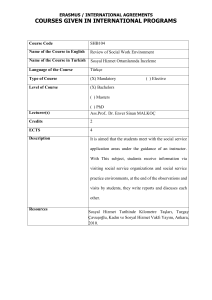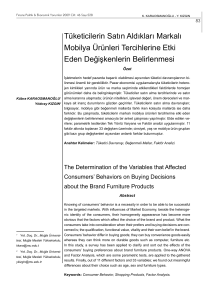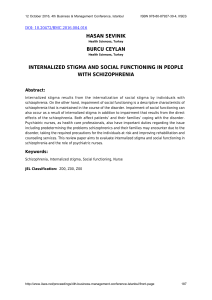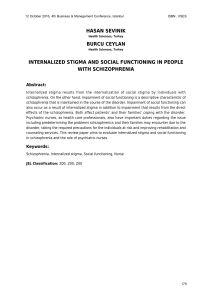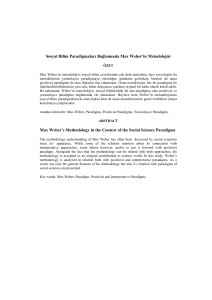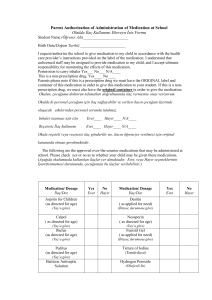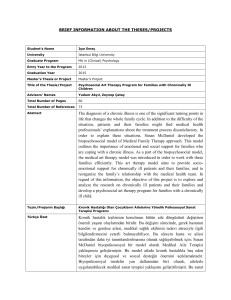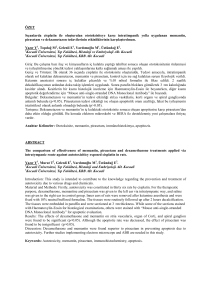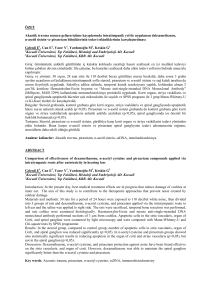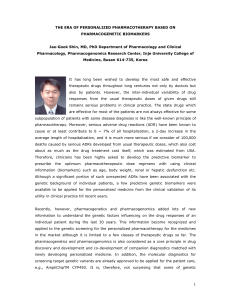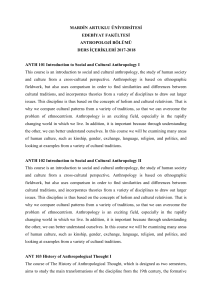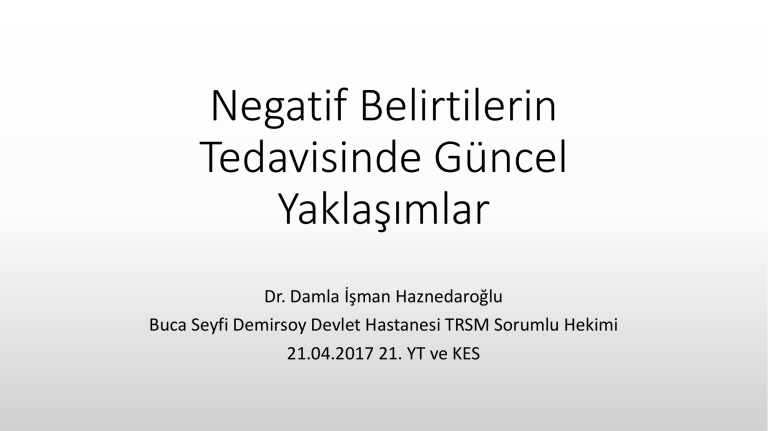
Negatif Belirtilerin
Tedavisinde Güncel
Yaklaşımlar
Dr. Damla İşman Haznedaroğlu
Buca Seyfi Demirsoy Devlet Hastanesi TRSM Sorumlu Hekimi
21.04.2017 21. YT ve KES
Sizler klinik pratiğinizde neler yapıyorsunuz?
• Son 40 yıldır şizofreni belirtilerini pozitif ve negatif olarak ayırabilmek
kolaylaştı
Pozitif belirtilerin tedavisi tabi ki önemli, ancak uzun
dönem epidemiyolojik çalışmalarda
• Pozitif belirtilerin zamanla azaldığı
• Negatif belirtilerin ise durağan kaldığı veya arttığı
gözlenmiş
*Goghari 2013, Heilbronner 2016, Mancevski 2007, Gur 1996, Pfohl 1982, Strauss 1972, Waters 2012, Buchanan 2007,
Milev 2005
DSM-5 ‘te negatif belirtiler
• Duygu dışavurumu azalması (örn: azalmış mimik/vokal
dışavurum ve göz teması)
• Avolusyon (örn: azalmış motivasyon)
• Aloji
• Anhedoni
• Asosyallik (örn: sosyal etkileşim fırsatlarına azalmış ilgi)
Birçok çalışmada şizofreniye bağlı süreğen yeti yitiminin
genellikle negatif belirtiler ve bilişsel zorluklar nedeni ile
olduğu bulunmuş
*Buchanan RW. Persistent negative symptoms in schizophrenia: an overview. Schizophr Bull. 2007;33(4):1013–22.
*Kurtz MM et al., Symptoms versus neurocognitive test performance as predictors of psychosocial status in schizophrenia: a 1- and 4-year prospective study. Schizophr Bull.
2005;31:167–74.
*Fenton WS et al, Antecedents, symptom progres- sion, and long-term outcome of the deficit syndrome in schizophrenia. Am J Psychiatry. 1994;151(3):351–6.
*Kirkpatrick B et al, A separate disease within the syndrome of schizophrenia. Arch Gen Psychiatry. 2001;58(2):165–71.
Negatif belirtiler Bilişsel performansta kötüleşme
• Negatif belirtilerin yaygınlığı genelde yüksek;
• 1452 hastanın içlendiği kesitsel geriye dönük
çalışmada
• %57 en az bir negatif semptom
• En sık rapor edilen sosyal içe çekilme, duygusal içe
çekilme
*Bobes J et al., Prevalence of negative symptoms in outpatients with schizophrenia spectrum disorders treated
with antipsychotics in routine clinical practice: findings from the CLAMORS study. J Clin Psychiatry.
2010;71(3):280–6
• Negatif belirtilerin şiddeti
• Bekar olmak
• İşsiz olmak
• CGI skorları ile belirlenen işlevsellikte düşüklük
• Yüksek doz antipsikotik almak ile ilişkili
Tedavi edebiliyor muyuz?
• İlaç dışı tedavilerden bazıları (ilaç tedavisine eklenerek)
1) Non invazif beyin uyarımı (rTMS- orta etki gücü)
2) Davranışsal terapiler (Bilişsel onarım, Sosyal beceri
eğitimi, BDT vb.)
3) Fiziksel egzersiz
Negatif belirtilerde ilaç tedavileri
Klinik çalışmaları okurken ........
Negatif belirtilerin önemli ve tedavisi zor olduğuna dair
ortak görüşe rağmen; yayınlarda negatif belirtiler için
kullanılan spesifik tanımlamalar, klinik çalışmaların
desenleri ve sonuç değerlendirme biçimleri oldukça
farklılık gösteriyor
• Birincil vs. İkincil negatif belirtiler ?
• Birincil--- hastalığın parçası
• İkincil– Örn: AP yan etkileri, sanrılara sekonder sosyal içe
çekilme, depresyona bağlı anhedoni
• Sadece “birincil negatif belirtiler” için tasarlanabilecek bir klinik
çalışmada
• Antipsikotik dozunu azaltmak?
• Monoterapi?
Sonuçların
genellenebilirliğine etkisi?
• “Yüksek doz alanların çalışma dışı kalması”
Primer negatif semptomlu hastaların bir kısmının dışlanmasına yol açabilir
• “Predominant negative symptoms”
• Geriye dönük, sabit seyirli 1-6 ay boyunca süren belirtiler
• Düşük düzeyde pozitif, depresif ve EPS belirtileri
Diğer dikkate değer noktalar
• Onam imzalayabilecek durumda olma Bir eşik düzeyde motivasyon
gerektirir (negatif belirtili hastalar için pek alışılmış değil)
• Sosyal izolasyon Klinik çalışmanın gerekliliklerini yerine getirememe
• Negatif belirti ölçekleri geçerliği
• Belli bir eşik üzeri pozitif belirtisi olan hastaların dışlanması
• Valide edilmiş biyomarker yokluğu Aday MRS, immun belirteçler,
fMRI rehberlikli non invaziv beyin uyarımı, elektrofizyoloji
İlaç tedavileri
• Antipsikotikler
• Antidepresanlar
• Antikonvulsanlar
• Stimulanlar
• Oksitosin
• Glutamat/GABA sistemini hedef alan ilaçlar
• Diğer ekleme tedavileri
Antipsikotikler
• Çalışma metodolojilerine dikkat !!!!
• İkinci kuşak AP orta düzeyde etki büyüklüğü
• Amisulpirid- ziprasidon kısmen daha fazla etki büyüklüğü
• İkinci kuşak AP’lerin konvansiyonel AP’lere göre belirgin üstünlüğü yok
• Kariprazin (D2/D3 parsiyel agonist) incelenmeye aday
Antidepresanlar
• İçlenen hastalarda depresif belirti düzeyi??
• Pozitif ve negatif çalışmalar
• Ekleme tedavi olarak kullanımını destekleyecek
düzeyde çalışma yok
• Mirtazapin ....
Antikonvulsanlar
• Lamotrijin- VPA Negatif
• Topiramat orta düzeyde etki gücü
Stimulanlar
• Veriler DEHB+Psikoz komorbid hasta çalışmaları
• Daha çok çalışmaya ihtiyaç var
• Modafilin/armodafinil Küçük etki gücü
Oksitosin
• İntranazal oksitosin Sosyal davranış artışı/sosyal kognisyon
• Negatif belirtilere etki belirgin değil
• Daha büyük ölçekli çalışmalara ihtiyaç var
Glutamat sistemi
• Şizofreninin glutamaterjik hipotezi ****
• Özellikle NMDA - AMPA Reseptörleri ilgili çekiyor
• Glisin, D-serin, D-sikloserin, sarkozin, bitopertin, memantin***,
minosiklin
• Rutin kullanımda ekleme tedavi olarak önerilecek düzeyde kanıt
henüz birikmedi
Diğer...
• Nikotinik Alfa7 reseptör agonist/parsiyel agonistleri
• Seks steroidleri
• Atorvastatin
......
Tedavi kılavuzları ne diyor?
APA
psychological treatments or other interventions. [2009]
Transfer
1.5.3.9
When a person with psychosis or schizophrenia is planning to move to the
catchment area of a different NHS trust, a meeting should be arranged between
the services involved and the service user to agree a transition plan before
transfer. The person's current care plan should be sent to the new secondary
care and primary care providers. [2009]
1.5.4
Psy
Psychological
chological interv
interventions
entions
© NICE 2014. All rights reserved. Last updated March 2014
Page 25 of 58
1.5.4.1 Offer CBT to assist in promoting recovery in people with persisting positive and
negative symptoms and for people in remission. Deliver CBT as described in
recommendation 1.3.7.1. [2009]
1.5.4.2
Offer family intervention to families of people with psychosis or schizophrenia
who live with or are in close contact with the service user. Deliver family
intervention as described in recommendation 1.3.7.2. [2009]
Original Paper
Evidence-based guidelines for
the pharmacological treatment of
schizophrenia: recommendations from the
British Association for Psychopharmacology
Thomas RE Barnes and the Schizophrenia Consensus Group of the
British Association for Psychopharmacology
Abstract
Journal of Psychopharmacology
0(0) 1–54
! The Author(s) 2011
Reprints and permissions:
sagepub.co.uk/ journalsPermissio
DOI: 10.1177/ 02698811103911
jop.sagepub.com
Royal Australian and New Zealand
College of Psychiatrists clinical
practice guidelines for the management
of schizophrenia and related disorders
Cherrie Galletly1,2,3, David Castle4, Frances Dark5,
Verity Humberstone6, Assen Jablensky7, Eóin
Killackey8,9, Jayashri Kulkarni10,11,
Patrick McGorry8,9,12,
Olav Nielssen13 and Nga Tran14,15
Abstract
Objectives: This guideline provides recommendations for the clinical management of
schizophrenia and related disorders for health professionals working in Australia and
New Zealand. It aims to encourage all clinicians to adopt best practice principles. The
recommendations represent the consensus of a group of Australian and New Zealand
experts in the management of schizophrenia and related disorders. This guideline includes
the management of ultra-high risk syndromes, first-episode psychoses and prolonged
engaged in care.
Non-government services. The Australian and New Zealand governments are making
significant investments in the non-government sector. NGOs provide a diverse range of
services to the mentally ill and are considered to be more flexible, responsive and innovative
than public mental health services.
NGO services provide a range of housing options, including staffed residential facilities for
people who require help with illness stabilisation, skill retrieval and development, and
community integration over a longer period of time. People with schizophrenia who have
disabling cognitive or negative symptoms can benefit from community support worker
interventions. These can range from low-level support, such as a face-to-face contact once
a week, to higher frequency support delivered after a comprehensive needs assessment in
the form of a ‘package of care’. Packages of care can consist of both individualised hours of
face-to-face support and assistance with the person’s physical environment and organising
their daily activities. Finding the most suitable services and coordination of care can be
difficult especially when there are numerous small NGOs, and improved links between NGObased community care services and clinical services are needed. Innovative models exist
where mental health and NGO clinicians are co-located and work as a virtual team providing
integrated care for people with significant mental illness.
NGOs also provide specific services to people from diverse cultural groups such as Australian
CBT for psychosis. CBT for people with psychosis (CBTp) has emerged as an evidencedbased treatment usually used as an adjunct to pharmacotherapy to reduce the distress and
disability associated with residual or persistent psychotic symptoms. CBTp is more effective
than other talking therapies such as supportive counselling for hallucinations, and there may
be long-term advantages for CBTp in dealing with emotional distress and depression, but
advantages over other therapies for overall mental state and delusions are not established
(Jauhar et al., 2014; Jones et al., 2012; Van der Gaag et al., 2014). The low risks and broad
potential symptom targets of CBTp have resulted in its use in both FEP and persistent
illness. A multicentre RCT of CBTp in people at risk of psychosis reported lowered symptom
severity but no impact on rates of transition to psychosis (Morrison et al., 2004).
Although positive symptoms were the initial targets of CBTp, research has also been
conducted using CBTp for negative symptoms and for comorbid depression, anxiety and
substance use (Wykes et al., 2008).
Cognitive remediation therapy and compensation. Cognitive remediation aims to improve
cognitive processes (attention, memory, executive function, social cognition or metacognition). There is emerging evidence of associated improved real-world function (Wykes
et al., 2011), but the outstanding issues for further research include the mechanisms of
change and ensuring real-world transfer. A number of cognitive remediation programmes
are available online, although not all of these programmes have been evaluated. The
evidence to date relies on programmes facilitated by clinicians trained in cognitive remediation
therapy (CRT).
Eve Giderken....
• FDA veya diğer düzenleyici otoriteler tarafından hiçbir tedavi
şizofrenide negatif belirtilere özel olarak onaylanmamıştır
• Diğer endikasyonlarda onayları olan bazı tedaviler;
antidepresanlar, topiramat, glutamaterjik tabanlı ilaçların
klinikte gözlenebilen ancak özgül olmayan orta düzeyde etki
büyüklüğü gözlenmiştir
• Gelecekte ümit vadeden olasılıklar glutamaterjik ilaçlar,
transkranyal doğru akım uyarımı
Dikkatinize teşekkürler...

